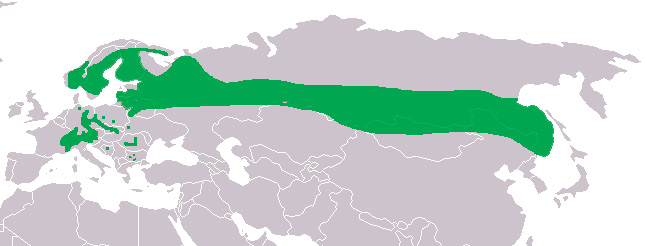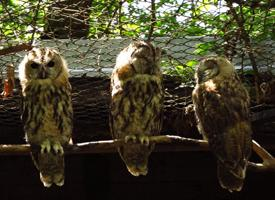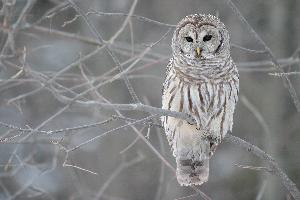
Váhy a míry
| Výška v kohoutku | 16 cm |
|---|---|
| Délka rozpětí křídel | od 43 do 45 cm |
Biologická data
| Počet mláďat | 5 - 6 |
|---|
Popis zvířete
The Eurasian Pygmy Owl (Glaucidium passerinum) is a captivating species, representing one of the smallest owls in Europe and the northern stretches of Asia. This diminutive bird of prey is a marvel of the avian world, with a suite of adaptations and behaviors that make it a fascinating subject of study for ornithologists and bird enthusiasts alike.Physically, the Eurasian Pygmy Owl is a compact bird, typically measuring between 15 to 19 centimeters in length, with a wingspan that ranges from 35 to 39 centimeters. Despite its small size, it possesses a robust and rounded body, a relatively large head for its size, and no visible neck. Its plumage is primarily a rich, mottled brown, with intricate patterns that provide excellent camouflage against the bark of trees. The owl's underparts are a lighter, more subdued shade, often streaked with darker markings. One of the most striking features of this species is its piercing yellow eyes, which are framed by whitish eyebrows, giving it a stern appearance. Another notable characteristic is its "false eyes" - two black spots on the back of the head, which are thought to deter potential predators by giving the impression that the owl is watching, even when it is facing away.
The Eurasian Pygmy Owl is diurnal, unlike many of its nocturnal cousins, which means it is active during the day. This behavior allows it to hunt for its prey, which primarily consists of small mammals like voles and mice, as well as a variety of birds, insects, and other invertebrates. Its hunting strategy involves perching quietly before swooping down on unsuspecting prey, using its sharp talons to capture and kill.
Breeding season for the Eurasian Pygmy Owl typically begins in early spring. The owl is a cavity nester, often utilizing the abandoned nests of woodpeckers or natural cavities in trees. The female lays a clutch of 3 to 7 eggs, which she incubates for about 28 days while the male provides food. Once hatched, the owlets grow rapidly, fueled by a diet of regurgitated food from both parents. They are ready to fledge in about a month, though they remain dependent on their parents for several weeks thereafter.
Habitat-wise, the Eurasian Pygmy Owl is versatile, inhabiting a range of environments from dense forests to mountainous regions. It shows a particular preference for coniferous woods, where it can find ample nesting sites and prey. Despite its adaptability, habitat loss and fragmentation pose significant threats to its populations in certain areas.
In terms of vocalization, the Eurasian Pygmy Owl has a distinctive call, described as a series of clear, mellow toots that can vary in tempo. This call plays a crucial role in territory establishment and mate attraction during the breeding season.
Despite its small stature, the Eurasian Pygmy Owl is a resilient and adept survivor. It exemplifies the incredible diversity of the owl family, showcasing unique adaptations that allow it to thrive in its specific ecological niche. While not currently considered endangered, its well-being is closely tied to the health of its habitat, highlighting the importance of conservation efforts to ensure this tiny predator continues to grace the forests of Europe and Asia for generations to come.
Mapa výskytu

Podobná zvířata
Nové fotografie zvířat
Top 10 zvířat
- Dolphin gull (Leucophaeus scoresbii)
- Diana monkey (Cercopithecus diana)
- Stone loach (Barbatula barbatula)
- Greek tortoise (Testudo graeca)
- Japanese macaque (Macaca fuscata)
- Moustached guenon (Cercopithecus cephus)
- Galápagos tortoise (Geochelone nigra complex)
- Russian tortoise (Testudo horsfieldii)
- Galápagos penguin (Spheniscus mendiculus)
- Common flying dragon (Draco volans)


